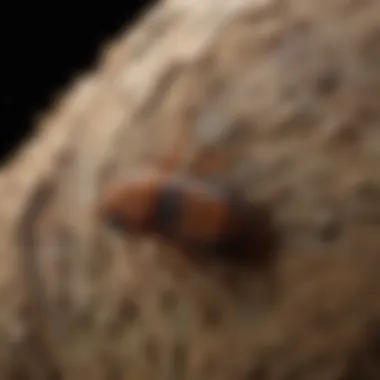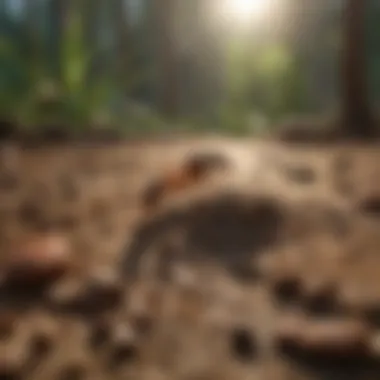Eastern Subterranean Termite Treatment Guide


Overview of the Topic
Definition and Importance
Eastern subterranean termites (Reticulitermes flavipes) are among the most destructive pests affecting wooden structures. Understanding their biology and behavior is vital for homeowners and professionals alike. These termites thrive underground and can cause extensive damage before signs of their presence are noticed. Thus, effective treatment and prevention methods are crucial in safeguarding properties.
Current Trends
Recent studies show a shift towards sustainable practices in termite management. Integrated pest management (IPM) combines biological, cultural, and chemical methods to control infestations. Researchers are focusing on organic solutions, reducing chemical use, and enhancing monitoring techniques. This shift reflects a broader trend in pest control, prioritizing environmental health while effectively managing termite populations.
Key Techniques and Practices
Step-by-Step Guide
- Identification: Recognize signs of infestation, such as mud tubes, discarded wings, and frass. Accurate identification ensures proper treatment measures.
- Inspection: Conduct thorough inspections of the property. Pay special attention to wooden structures, basements, and crawl spaces where termites are most likely to thrive.
- Treatment Selection: Choose a suitable treatment method. Options include liquid termiticides, baiting systems, and barrier treatments, depending on the severity of the infestation.
- Application: Follow safety protocols for applying treatment. Ensure the product is used in accordance with manufacturer guidelines.
- Monitoring: After treatment, continuously monitor the area for any signs of reinfestation. Use monitoring stations to track termite activity.
Tools and Equipment Needed
- Inspection Tools: Flashlight, moisture meter, and probing tools for detection.
- Treatment Supplies: Termiticides, bait systems, and protective gear such as gloves and masks.
- Monitoring Devices: Bait stations and inspection tubes for ongoing monitoring.
Challenges and Solutions
Common Obstacles
- Undetected Infestations: Termites often go unnoticed until significant damage occurs. Regular inspections are essential to combat this issue.
- Resistance to Treatments: Some populations may develop resistance to certain chemicals. This reinforces the need for rotating treatment methods.
Innovative Solutions
- Natural Predators: Research is underway on using natural termite predators as a form of biological control. This method could complement chemical treatments.
- Smart Monitoring Technology: Advanced monitoring systems using sensors can help detect termite activity in real-time, enabling quicker responses to potential infestations.
"Adopting a proactive approach in termite management can save properties from extensive damage and costly repairs."
By understanding the behavior of eastern subterranean termites and implementing effective treatment strategies, homeowners can protect their investments while contributing to sustainable pest management practices.
Prelude to Eastern Subterranean Termites
Understanding eastern subterranean termites is crucial for property owners, farmers, and enthusiasts. These pests are not only a threat to structures but also have significant implications for agriculture. An infestation can lead to extensive damage, which is expensive to repair. Knowing how these termites operate supports timely interventions, potentially saving both time and money. This article aims to present a detailed exploration of eastern subterranean termites, emphasizing effective treatment approaches and the importance of proactive measures.
Understanding Subterranean Termites
Subterranean termites, specifically the eastern kind, thrive underground, which allows them to go unnoticed until severe damage occurs. Their existence is marked by a complex behavior and a remarkable ability to destroy wooden structures. Grasping their habits and habitats is key to understanding how to combat them. These termites work as a colony, accessing food sources and shelter while remaining shielded from many predators.
Biology and Behavior
Life Cycle
The life cycle of eastern subterranean termites consists of several stages: egg, nymph, and adult. This complex growth process is essential for colony expansion. Eggs hatch into nymphs, which mature into reproductive adults. It is fascinating to note that under optimal conditions, a single colony can produce thousands of new termites each year. The rapid reproduction rate means infestations can escalate quickly, making early detection critical for control.
Colonial Structure
Colonial structure entails a defined hierarchy within the colony. In eastern subterranean termites, the queen is central, laying eggs to ensure survival. The worker termites execute tasks like building tunnels and foraging for food. Soldiers protect the colony. Understanding this hierarchical organization helps in developing targeted treatment plans that can disrupt their life processes. Notably, the colony's size can reach millions, amplifying the risk associated with infestations.
Feeding Habits
Eastern subterranean termites primarily consume cellulose, which is present in wood and plant material. Their feeding habits not only facilitate their growth but also lead to extensive structural damage in homes and agricultural setups. They require moisture to maintain their health, often leading them to structures where wood is in contact with soil. This unique adaptation highlights their resilience, making it imperative to use specialized treatment options that directly target their feeding behavior.
Identifying Termite Infestation
Identifying termite infestations is crucial to mitigating structural damage and preventing costly repairs. Early detection can significantly reduce the overall impact of these pests on properties. Knowledge of specific signs, inspection techniques, and behavior patterns ensures that infestations can be managed effectively. Without proper identification, homeowners may overlook potential threats, leading to extensive damage and financial loss.
Signs of Infestation
Recognizing the signs of termite infestation is the first step in addressing the problem. There are several indicators that may reveal a termite presence in a structure, including subterranean termite tubes, wood damage patterns, and the emergence of swarmers.
Subterranean Termite Tubes
Subterranean termite tubes are mud-like structures created by termites to travel between their nest and food sources. These tubes are a key characteristic of subterranean termites. They provide shelter from the open, allowing termites to remain hidden while accessing wood materials. The presence of these tubes is a strong indicator of an active infestation.
One unique feature of subterranean termite tubes is their construction. They are often found in moist areas and can be seen alongside walls or foundations. The advantage of identifying these tubes is that they lead directly to nesting sites and points of damage within a home.


Wood Damage Patterns
Wood damage patterns are another significant indicator of termite activity. Subterranean termites consume wood from the inside out, leaving a thin layer of wood that may appear intact on the surface. This behavior creates distinctive signs, such as hollowed-out sections or tunnels within the wood itself.
Recognizing these patterns is beneficial for determining the extent of an infestation. Inspecting wood for signs of damage can aid in locating infested areas and assessing the need for treatment. However, wood damage patterns may not always present obvious signs until significant damage has occurred, making awareness of other indicators essential.
Presence of Swarmers
Swarmers are winged reproductive termites that leave the colony to establish new nests. They often emerge during warmer months, indicating reproductive cycles. The presence of swarmers, particularly near windows or light sources, suggests that a nearby colony is active.
The key characteristic of swarmers is their distinctive appearance: they have long, straight wings and are typically dark in color. They can be a beneficial sign for homeowners as their emergence often indicates a nearby infestation that could be treated before spreading. However, the emergence of swarmers may also indicate that a colony has already established itself nearby, which can create a sense of urgency for inspection and treatment.
Inspection Techniques
Effective inspections are vital for accurate identification of termite infestations. Various methods, such as visual inspections, using moisture meters, and employing specialized termite detection tools, play a role in assessing potential problems.
Visual Inspections
Visual inspections involve systematically checking the property for signs of termite activity. This technique places emphasis on identifying both external and internal indicators, such as mud tubes, wood damage, and fecal pellets.
The primary advantage of visual inspections is that they require no specialized equipment. Homeowners can conduct them independently. However, it is important to note that detecting termites solely through visual inspections can be challenging, as some infestations may remain hidden within walls or foundations.
Using Moisture Meters
Moisture meters can be particularly useful in inspections. They measure the moisture content in wood, which can indicate potential termite activity. Termites thrive in damp conditions, making high moisture levels a potential sign of surrounding infestation.
The key benefit of using moisture meters is their ability to detect hidden moisture behind walls. This can lead to earlier detection of problems. However, it is crucial to note that high moisture readings can also be caused by other issues, such as plumbing leaks, which may complicate interpretation of results.
Termite Detection Tools
Various termite detection tools are available that use technology to identify infestation. These include acoustic devices that listen for termite activity or infrared cameras that detect temperature changes caused by colonies.
The advantage of using these specialized tools is their ability to locate termites hidden from plain view. They offer a more comprehensive examination than visual means alone. However, these tools are often expensive and may require professional training for effective use, which could limit accessibility for some homeowners.
Identifying termite infestations is an essential first step in managing the threat of eastern subterranean termites. Recognizing the signs and employing thorough inspection techniques can significantly improve the chances of early detection, ultimately protecting property from the damaging effects of these pests.
Impact of Termite Infestation
Understanding the impact of termite infestation is crucial for both property owners and farmers. Termites, especially the eastern subterranean variety, can cause significant problems if not managed properly. Their presence is often not detected until they have caused extensive damage, making early identification and treatment essential. This section elaborates on the structural damage these pests can inflict and the economic ramifications associated with such infestations.
Structural Damage
Subterranean termites are notorious for their ability to weaken wooden structures. They consume cellulose, which is found in wood, drywall, and other building materials. As they burrow through beams and foundations, they compromise the integrity of structures. This kind of damage can be catastrophic, often leading to costly repairs.
Moreover, signs of structural damage may not be immediately visible. Often, infestations can progress unnoticed until serious issues arise, such as sagging floors or collapsing ceilings. Property owners are advised to conduct regular inspections to catch infestations early.
The following are key characteristics of the structural damage caused:
- Hidden Nature: Damage often occurs inside wood, making it hard to discover.
- Progressive Damage: If left untreated, damage can escalate rapidly.
- Impact on Safety: Compromised structures pose safety risks to inhabitants.
Economic Consequences
The economic impact of termite infestations extends beyond immediate repair costs. When termite damage is discovered, property values can plummet, and the costs of treatment can be substantial. Below are specific aspects to consider:
Repair Costs
Repair costs are one of the most significant aspects affected by termite infestation. High costs often stem from extensive damage, which can require more than just superficial fixes.
- The estimates for repair can vary greatly, often running into thousands of dollars.
- Many property owners overlook the long-term financial implications of untreated infestations.
A key characteristic of repair costs is their unpredictability; extensive damage is usually much more expensive to fix than catching an infestation early. This point reinforces the importance of regular inspections and preventative treatments to avoid exorbitant costs in the future.
Insurance Implications
Insurance implications can be complex when dealing with termite damage. Many insurers do not cover damages resulting from pest infestations, putting the financial burden solely on the property owner.
- It's crucial to understand your insurance policy regarding pest infestations.
- Being informed about coverage can save property owners from unexpected expenses.
Unique to insurance implications is the potential for a higher premium. If a property has had previous infestations, insurers might categorize it as high-risk, leading to increased rates in the future.


Property Value
The presence of termites can severely affect property value. Homes and structures known to have had termite issues can lose appeal to potential buyers.
- A history of termite infestation is often a red flag for buyers.
- Properties may sell for significantly less than homes without such history.
Understanding the impact on property value highlights the importance of effective management strategies. Maintaining a pest-free environment can help preserve the value of agricultural and residential real estate.
Effective management strategies can greatly enhance the longevity and structural integrity of properties while safeguarding economic investments.
Treatment Options for Eastern Subterranean Termites
Treatment options for eastern subterranean termites are essential to managing infestations effectively. Knowing the different types of treatments allows property owners to make informed decisions. Each method has specific benefits and considerations. The goal is to eliminate the termites while minimizing risks to humans and the environment.
Chemical Treatments
Chemical methods are widely recognized for their effectiveness in controlling termite populations.
Liquid Termiticides
Liquid termiticides are a common choice in termite treatment. These chemical solutions penetrate the soil and create a barrier against termites. One key characteristic of liquid termiticides is their ability to offer long-term protection. They provide a quick solution, often showing results in days.
The unique feature of these products is that they can be applied as a preventative measure as well. \n However, some disadvantages exist. Liquid termiticides may pose risks to humans and pets if not applied correctly. Furthermore, their effectiveness can diminish over time due to various factors like soil movement and rainfall.
Baiting Systems
Baiting systems are another popular method for controlling termites. They involve placing bait stations around the property. The key characteristic of baiting systems is that they use a slow-acting insecticide, allowing termites to carry the poison back to the colony. This helps eliminate not just the foraging termites but also their queen and other members.
A significant advantage of baiting systems is their environmental safety. They reduce the need for widespread chemical applications. However, a drawback is that baiting systems may take longer to show effectiveness compared to liquid treatments. Property owners must be patient and monitor the stations regularly.
Non-Chemical Treatments
While chemical treatments are effective, non-chemical methods present alternative options for termite control.
Physical Barriers
Physical barriers provide a preventative approach against termites. These barriers can include concrete foundations and steel mesh. A crucial characteristic of physical barriers is their ability to stop termites before they enter a structure. They are a durable option and can provide long-lasting protection.
One unique feature is their ability to work in tandem with other methods to enhance their effectiveness. However, they may require significant upfront investment and planning during construction, which could be seen as a disadvantage.
Biological Control Methods
Biological control methods tap into natural predators or parasites of termites. The key characteristic of these methods is their minimal impact on the environment. Using organisms such as nematodes can disrupt termite colonies without harmful chemicals. These methods are increasingly popular among environmentally conscious property owners.
Nevertheless, biological methods often require a longer timeline to effectively reduce termite populations. Also, they may not be as effective in severe infestations compared to chemical options.
Integrated Pest Management
Integrated Pest Management, or IPM, combines various strategies for effective termite control.
Combining Methods
Combining methods allows property owners to create a comprehensive treatment plan. This approach integrates both chemical and non-chemical strategies. A significant benefit of combining methods is improved effectiveness. Each method can complement the others, addressing different aspects of the infestation.
A notable feature is its adaptability. Property owners can adjust their plan based on observed termite activity. However, it requires careful planning and monitoring, which may not be feasible for everyone.
Ongoing Monitoring
Ongoing monitoring is a critical component of effective termite management. Regular inspections after treatment help detect any new activity. The key characteristic of ongoing monitoring is its proactive nature. By identifying problems early, property owners can take corrective action before severe damage occurs.
A unique feature of this approach is that it encourages continual vigilance. While this may feel burdensome, the long-term savings from early detection can surpass the effort required. However, ongoing monitoring necessitates a commitment to regular inspections and may require professional assistance.
Prevention Strategies
Prevention strategies play a critical role in managing eastern subterranean termites. Effective prevention not only safeguards structures but also minimizes the need for costly treatments once an infestation occurs. Implementing strategic measures reduces the likelihood of termite presence and their potential harm to properties. Furthermore, understanding how to create an unfavorable environment for termites can save time and resources. By focusing on structural modifications and landscape controls, property owners can significantly lower infestation risks. This section outlines essential approaches that contribute to effective long-term termite management.
Structural Modifications
Adequate Drainage


Adequate drainage is vital for preventing moisture buildup around a property. Subterranean termites thrive in humid conditions, making effective drainage systems crucial. A well-designed drainage system can channel water away from foundations and lower the moisture levels in the soil surrounding structures. This reduces the attraction for termites.
The key characteristic of adequate drainage is its ability to create a dry perimeter around the home. Properly installed gutters, downspouts, and sloped landscaping promote effective drainage. In this article, it is a beneficial choice because it complements other preventive methods.
A unique feature of adequate drainage is the ability to direct rainwater away efficiently. Advantages include a reduced risk of flooding and lower moisture levels, which directly contribute to termite prevention. However, one must consider the initial costs and maintenance requirements of these systems.
Ventilation
Ventilation is another essential aspect. Proper ventilation in crawl spaces and attics helps to maintain lower humidity levels in these areas. This is essential as high humidity can create an inviting environment for termites. The key characteristic of ventilation systems is their ability to circulate air, thereby reducing moisture accumulation.
In the context of prevention strategies, it is a popular choice for homeowners. This adequately reduces the risk of structural damage caused by termites.
Unique to ventilation systems is the option for passive or active designs. Passive systems can be cost-effective and require little maintenance, while active systems might provide better control but come with higher initial costs. Each option presents advantages and disadvantages concerning efficiency and cost.
Landscape and Environmental Controls
Reducing Moisture Sources
Reducing moisture sources around a property is fundamental to termite prevention. Subterranean termites require water to thrive, making the elimination of moisture sources crucial. Key characteristics include the removal of standing water and improving surface drainage. It is a beneficial strategy because it not only deters termites but also improves overall lawn health.
A unique feature of reducing moisture sources is its multifaceted approach. This can involve redirecting sprinkler systems and removing debris that holds water. Advantages include a lower risk of infestation and healthier garden ecosystems. However, it requires ongoing vigilance to ensure moisture does not accumulate again.
Proper Mulching Practices
Proper mulching practices are significant in controlling moisture levels around a property. Organic mulches, like wood chips, while beneficial for gardens, can retain moisture and attract termites. The key characteristic of proper mulching involves choosing species that do not retain excessive moisture.
In the context of preventing termite infestations, it is advised to use inorganic materials or limit thickness of organic mulches. This makes it a beneficial point in the article because it emphasizes informed choices for landscaping.
A unique feature of this practice is the ability to enhance aesthetics while minimizing risks. Advantages of proper mulching include improved plant health and reduced pest attractiveness. However, if not monitored, organic mulch can undermine the intended moisture reduction goals.
Current Research and Innovations
The realm of termite treatment is constantly evolving. Innovations and research developments are essential for agriculture farmers and enthusiasts who face challenges brought by eastern subterranean termites. This section highlights two significant domains: emerging treatment technologies and biocontrol agents. Both approaches focus on reducing reliance on conventional chemical treatments and promoting more sustainable practices.
Emerging Treatment Technologies
One of the key innovations in termite management is the advancement of treatment technologies. These include novel formulations of pesticides and the development of more efficient delivery systems. Recent research has focused on creating treatments that target the specific behaviors and biology of eastern subterranean termites. New options, such as targeted bait systems, offer higher efficacy and lower environmental impact.
For instance, innovations in baiting technologies allow precise application of substances that disrupt termite activity. These bait systems contain slow-acting chemicals, which termites ingest and share with colony members. Such targeted approaches can lead to quicker reductions in termite populations while minimizing effects on beneficial insects.
Some researchers are also exploring the use of nanotechnology in pesticide formulations. By engineering particles at the molecular level, it is possible to enhance the penetration and effectiveness of chemical solutions in wood and soil, thus increasing their efficiency in controlling infestations.
Biocontrol Agents
Biological control, or biocontrol, represents another frontier in termite management. This approach utilizes natural predators or parasites to suppress termite populations. Research in this area is aimed at identifying native organisms that can be effectively applied in pest management.
Examples of biocontrol agents include:
- Entomopathogenic nematodes: These microscopic roundworms can infect and kill termites. They offer a non-toxic solution that aligns with sustainable agricultural practices.
- Fungal pathogens: Certain fungi can also act as biological agents against termites. Fungi like Beauveria bassiana infect and ultimately kill termites, offering another avenue of control.
The benefits of using biocontrol agents include lower environmental impact and reduced human health risks. Moreover, biocontrol can potentially offer more controlled and longer-term management of termite populations.
The integration of biocontrol methods with traditional pest treatments could pave the way for more effective and sustainable termite management solutions.
Current research in these fields not only seeks to provide immediate solutions but also lays the groundwork for a future in which sustainable practices dominate pest management. For farmers, understanding these developments will allow for more informed decisions, fostering long-term resilience against subterranean termite threats.
Closure
The conclusion serves as the final synthesis of all the insights explored throughout this guide. It is crucial because it reinforces the significance of comprehending eastern subterranean termite treatment. By summarizing the methods, implications, and future considerations, readers can better grasp the holistic approach needed to manage these pests effectively.
Summary of Treatment Approaches
There are various treatment strategies for combating eastern subterranean termites. Each approach has unique advantages and limitations:
- Chemical Treatments: One of the most common methods involves liquid termiticides and baiting systems. Liquid applications create a barrier in the soil, while baiting systems offer an alternative by reducing termite populations over time.
- Non-Chemical Treatments: Physical barriers, such as steel mesh or concrete, can prevent termite entry. Biological control methods utilize natural predators or pathogens to manage termite populations without chemical exposure.
- Integrated Pest Management: This comprehensive approach combines various methods to enhance effectiveness. It focuses on maintaining ongoing monitoring and adjusting strategies based on observed termite activity.
In summary, employing a combination of these treatment options will yield the best results. This diverse approach allows for resilience against resistant termite colonies, fostering long-term control.
Future Directions in Termite Management
Looking forward, termite management strategies will benefit from continued research and innovation. Several key areas show potential for improvement:
- Emerging Technologies: Advances in pest control technology will facilitate new treatment formulations and application methods. More precise targeting could boost effectiveness while minimizing environmental impact.
- Biocontrol Agents: Ongoing research into beneficial organisms presents an exciting opportunity. Utilizing insects or fungi that naturally control termite populations offers a sustainable alternative to chemical treatments.
- Sustainability Focus: There will be an increasing emphasis on eco-friendly practices in pest management. Techniques that reduce chemical reliance align with contemporary environmental concerns, demonstrating that pest control can be effective and responsible.
Continued innovation coupled with a commitment to sustainability will shape the future of termite management, ensuring that solutions remain effective and environmentally sound.



